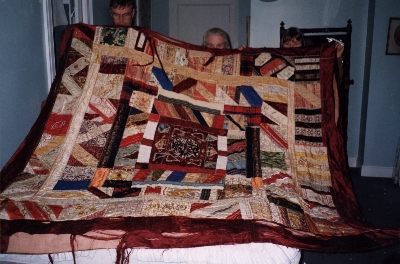Quilt No.581LC - Lorna Calder

The quilt was made by Jane Calder (born Bennett) in Melbourne probably just before the turn of the century. Jane was known as 'Mater' in the family. It descended through the maker's family and came to Lorna Calder on the death of her mother-in-law in 1948. The quilt was found in an old tin trunk in the cellar of her Melbourne home in Grey Street, St. Kilda. In 1980 Mrs. Calder had the quilt repaired for her daughter Morella's return to Australia and it was used in her Balmain home. Additional initials relating to Mrs. Calder's family had been added by the Austrian needlewoman, Soula, who did the repairs. The quilt came back into Lorna Calder's hands on the death of her daughter. It is not used.
The Calder family were from Edinburgh. Jane Bennett married William Henderson Calder in about 1860 and they went to New Zealand. She had nine children in New Zealand and they returned to Scotland in 1875. After a year or two the family came to Australia and settled in St. Kilda in a large house that still stands in Grey Street. Unfortunately much of the information about the quilt died with Lorna Calder's mother-in-law.
[Based on informal interview with Lorna Calder by Kylie Winkworth 15.9.99]


Related Quilts:
2134 x 2134mm
1870 x 950mm
1400 x 930mm
840 x 840mm
3050 x 2031mm
2591 x 2566mm






